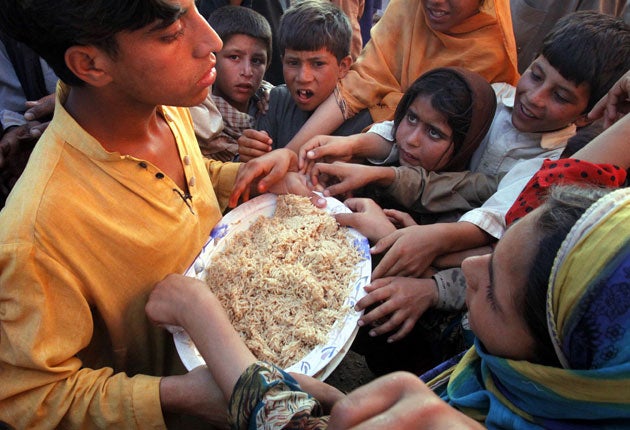Refugees' plight worsens in searing heat
100F temperatures confront masses who have fled the Swat Valley conflict

At the height of the bright white midday burn-out, the refugees from the hills were hiding from the Jalala sun.
They had hung up some tarpaulins at the base of an electricity pylon and they sat there – three families in all – covering their heads and wafting themselves hopelessly with bamboo fans. In this corner of the North-West Frontier Province, the temperature was at least 100F (38C), and the refugees looked ready to expire.
"The tent is so hot. If you're inside the tent during the day you are very brave," said Gul Mohammed, a shopkeeper from Rahimabad in the Swat Valley. "We can only go inside our tent in the evening, and even then it's full of mosquitoes. That's why we are here, hiding under these tarpaulins."
The hundreds of thousands of refugees now pouring out of the mountainous Swat are used to cooler climes and clean air – but they are running straight into the perilous embrace of Pakistan's sweltering summer. Aid officials warn that the soaring temperatures are already taking a merciless toll on the refugees. Children in particular are falling victim to heat stroke and dehydration. And in such cramped conditions and with poor sanitation and little water, the heat makes it more likely that diseases will spread.
"What I'm worried about is the heat," said Professor Isa Khan, head of the Rehman Welfare Foundation, who heads an emergency clinic at the Jalala refugee camp, two hours north-west of Islamabad. "It's 100 degrees today. When it soars to 106 in the next couple of days there will be a very serious situation – heat strokes, dehydration and the spread of diseases such as cholera and hepatitis. The first day I arrived here two women died from heat stroke."
The problem, said Dr Khan, was that there was simply no way to keep people cool. The tents housing about 8,000 people had no access to electricity to power fans, even if there were any fans to hand out. Nor is there any means of making ice. "I've been requesting an emergency tent with air conditioning," added Dr Khan. "We have no way of immediately cooling someone."
In breezeless, blistering conditions there was literally nowhere to avoid the heat. Two heavily bearded brothers, Zafar and Shaukat Ali, from the city of Mingora, were both sweating heavily as they walked through the dusty camp. "It's not great here," said Zafar, a rickshaw driver. "There's no way to escape the heat, it's everywhere. It's hot inside the tent, it's hot outside of the tent. Even the water is hot."
On a visit to nearby Yar Hussain, Antonio Guterres, the UN High Commissioner for Refugees, told reporters: "People are living in very harsh conditions under the sun – [the] very hot sun."
Experts say the impact of the high temperatures amid the closely pitched tents, bisected by ditches of filthy, stinking water, will only worsen as more people come to the camps. "People are living in hot, cramped conditions with limited water and food," said Maria Luiza Galer, a health official with the British charity, Merlin. "They just keep arriving, adding to the already over-crowded camps. It is a race against time to prevent an outbreak."
Already overstretched by the 900,000 people estimated by the UN to have fled from Swat and the surrounding areas of Buner and Lower Dir in the past three weeks, officials are bracing themselves for more. Yesterday thousands of refugees streamed from Swat after the military temporarily lifted a curfew, allowing residents to escape so that it can engage the militants in "street-to-street fighting".
Witnesses told how a column of cars, trucks and horse-drawn carts loaded up with people and possessions poured from Mingora. On the way they had to pass burnt-out vehicles that had not made it. The army claimed that it had received reports that some of the Taliban fighters they have been battling were shaving their beards and cutting their hair and trying to escape the conflict among the exodus of refugees.
The majority of the refugees flooding from the mountains are staying with members of their extended families or else in rented rooms, but about 80,000 people have no alternative but the 20-odd camps, most of them around the city of Mardan.
Saeed Haider Ali, of World Vision, said that in addition to the physical health problems, the heat also caused psychological issues. "It's ominous. The heat is unbearable," he said. "These people come from much cooler areas and their skin is very sensitive."
Aid officials say they are scrambling to provide fans for the tents, something that may ease the situation just a little. In the meantime, the refugees are going to continue to burn. "Look at these tents and the place where they are set up. Can someone from a cool region live here? There are no fans, no cold water, nothing," Maryam Bibim, a mother of four who had recently arrived at Yar Hussain, told Reuters. "Do you want our children to die of heat stroke? Even at night my kids can't sleep because of the heat. They cry but what can I do?"
Join our commenting forum
Join thought-provoking conversations, follow other Independent readers and see their replies
Comments
Bookmark popover
Removed from bookmarks